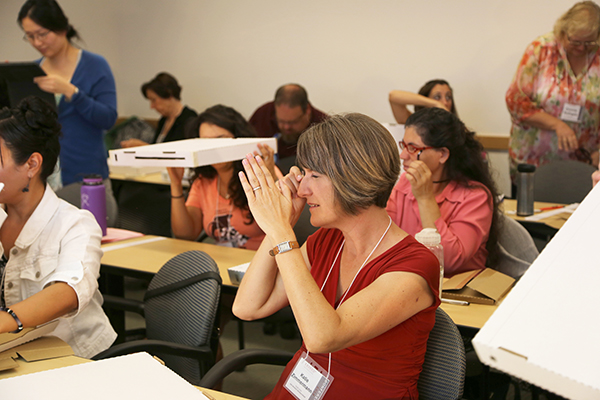In science, a dynamic event rearranges one state into another, with a distinct before and after. It is an energetic force that produces change.
This is the kind of power that is released in young people’s minds when a teacher helps them understand a new topic in a way that’s exciting to them. The provost of Loma Linda University, Ron Carter, PhD, made this point during his introductory remarks for last week’s EXSEED conference at Loma Linda University Health.
Ninety-four educators attended the conference held July 13-17 — five school principals, 78 teachers and 11 teachers/principals or administrators.
EXSEED’s purpose is to help educators — specifically kindergarten through 12th grade teachers — enlighten their students in a way that makes such moments possible. The conference’s name stands for Excellence in STEM Experiential Education.
The STEM disciplines — science, technology, engineering and mathematics — play a key role in advancing solutions to the world’s problems and in keeping the United States on pace with the technological world. Relative to Loma Linda University Health, students majoring in STEM disciplines have a great foundation for a career in the health sciences.
Teachers are the most important people in their students’ lives for making them believe that they can be successful, noted the president of Harvey Mudd College, Maria Klawe, PhD, during her keynote address. She stressed the importance of teachers in helping girls and women believe they can succeed in a STEM career.
Teachers must eradicate the “cultural mythology” that says girls aren’t good at STEM, that women don’t make great scientists, that technology is a man’s game, Klawe argued.
Following the inspirational opening morning of EXSEED, plenary presenters spoke, and each teacher in attendance was given an iPad and taught how this tablet can be put to great use in the classroom.
For the following two days, teachers in attendance had their choice of about 30 workshops on specific teaching ideas to incorporate in their classrooms. Teachers could choose between sessions that helped them understand creative project ideas to do with students, theoretical bases of STEM, digital and technological literacy, and even grant writing to help them obtain funds for their classrooms.
For the fourth day of the conference, attendees heard from researchers on campus who shared new developments in the health sciences, toured the Medical Simulation Center, and learned more about using their iPads.
On closing day, the teachers presented their group projects in which they had used their iPads to create videos demonstrating teaching ideas.
The attendees were also introduced to Tom and Vi Zapara, who have provided financial and emotional support to EXSEED.
Tom Zapara briefly took the microphone to share his thoughts about education, and he remarked on the critical importance of teachers in society.
Many attendees later spoke with the Zaparas, thanking them for helping make EXSEED possible. A delegation of teachers from Jamaica expressed appreciation to the Zaparas and leaders of EXSEED.
Of the teachers who attended EXSEED 2015, about 80 percent of them come from Seventh-day Adventist schools nationwide. Other attendees teach in local public schools and schools in Mexico and Jamaica.
“Every year I feel better about the future knowing another 100-plus K-12 educators are going to inspire thousands of students to enjoy STEM topics because of EXSEED,” says Doug Havens, director of EXSEED.
EXSEED was first held in 2011 and has been repeated each summer since to empower as many teachers as possible who are educating the next generation of STEM leaders. The innovative and collaborative program empowers K-12 teachers in Adventist schools to teach integrated STEM courses within the context of Mission-Focused Learning. Mission-Focused Learning is the hallmark of education at Loma Linda University.
“When we look at what society truly needs, it is individuals who are problem solvers, who are innovators,” says Carter, who in addition to serving as provost of Loma Linda University, is co-executive director of EXSEED.
Fostering the development of such individuals, EXSEED is a partnership between K-12 educators, schools and organizations, as well as higher education partners including Andrews University, Kettering College, La Sierra University, Pacific Union College, Walla Walla University and the Pacific Union Conference, with Loma Linda University hosting and facilitating.

